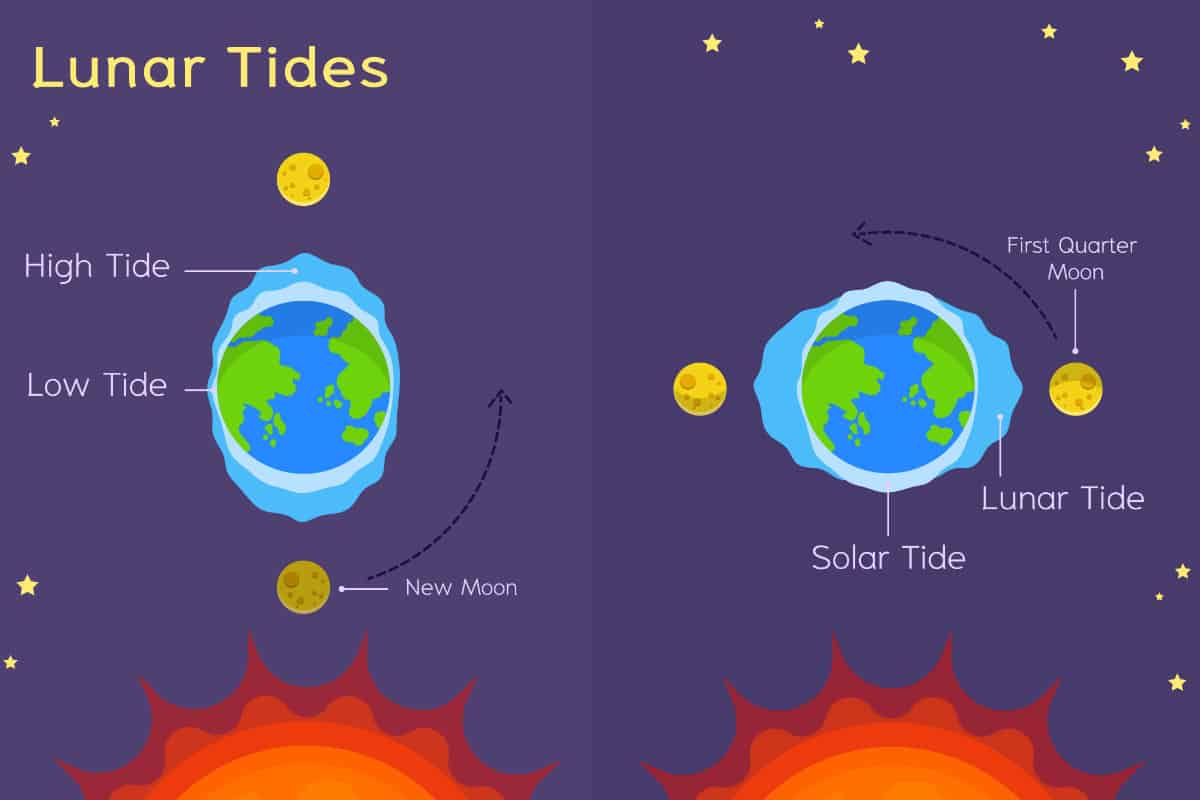Is there a perfect time to catch fish? Could going early in the morning or late at night help make your fishing or hunting expedition smoother? Do you want a chance to catch a world record fish, but don’t want to waste hours of your time on the ocean without any bites? The solunar theory is one that many anglers have heard about and used in the past. When the charts are read well, it can make fishing more successful and enjoyable.
The solunar theory![]() is based on the idea that all animals, marine life and wildlife, move according to the moon’s movements. When the moon is right above or below them, the animals are more likely to be active, which is the perfect time to fish or hunt.
is based on the idea that all animals, marine life and wildlife, move according to the moon’s movements. When the moon is right above or below them, the animals are more likely to be active, which is the perfect time to fish or hunt.
Many anglers are interested in using the solunar theory to increase their chances of a good day fishing. This article will help explain the solunar theory, how it works, and how it helps anglers. Understand when marine life, and other animals, are more likely to be active.
What Is the Solunar Theory?
The solunar theory is an idea that animals will move according to the moon’s location compared to their bodies. Many hunters and anglers notice specific times of the day and specific days of the month when animals are more active. The Solunar theory helps to explain when these times are more likely to occur.
When wildlife is more active, this is good for a fishing or hunting trip. It helps you get a better guarantee, in most cases, of being successful. Although this isn’t always going to explain fish and other animals’ movements, it is a theory that many anglers and hunters swear by when they go out.
Many anglers have found that this theory is accurate for predicting fish and marine life’s most active time. They then choose to follow the solunar tables to pick the right times to make their next fishing trip.
According to this theory, when animals are more likely to be active, the times of day are known as the solunar periods. You will find that each lunar day has four periods, and each lunar will last 24 hours and 50 minutes.
Since this is slightly off our 24-hour clock, a solar day![]() will usually, but not always, have all four periods. Each of these four periods is split up into two minor and two major periods.
will usually, but not always, have all four periods. Each of these four periods is split up into two minor and two major periods.
The major periods will last two hours and begin right when the moon is above our heads and again when the mood is right below our feet or on the other side of the world.
These two periods are important to pay attention to because they are the hours where fish are the most active during the day. If possible, anglers should get out on the water to catch a good fish.
The minor period is important, as well. These periods will only last an hour. They correspond back to the rising and the setting of the moon. These periods may not have as much activity as you can see with the major periods, but they are still busier than the rest of the day.
Fishing during the major and the minor period will give the most activity for your endeavor. While you may be able to catch something during any time of the day, you have the highest likelihood of catching some good fish during the major periods. Still, it is a fairly decent chance when you are working with the minor periods.
The History
To understand how the solunar theory works, it is important to take a closer look at history. In 1926, John Alden Knight![]() got started on a bit of research.
got started on a bit of research.
Putting together a few different resources, such as fishing folklore and other factors, he thought influenced fishing, like the moon and the sun. He was able to form a theory based on these to understand all animals’ movements better.
During this research, Knight compiled a list of factors that controlled or influenced the behavior that many saltwater and freshwater fish exhibited. He was thorough, taking a look at 33 different factors that he assumed would influence marine life.
Each one of these factors was considered, but all of them, besides three, were rejected in the end. The three factors that made it past Knight’s testing included the sun, the tide, and the moon.
For fishing in saltwater, including surf fishing, the tides have always been a big factor that controls how marine life behaves. As Knight continued to progress in his research, he found something interesting.
In the past, many assumed that it was just the tides themselves that were the influence. Knight found that the sun and moon’s position relative to one another could also be a factor. He also found that the time between moonrise and sunrise was important.
This research determined that there were different times of day that could occur between the two major periods. This is where the idea of the four periods of this theory came from.
The two major periods happened between the moon going up and the moon coming down. And then there were the minor periods as well. From this information, Knight was able to publish his first Solunar table in 1936.
How The Tides Fit In
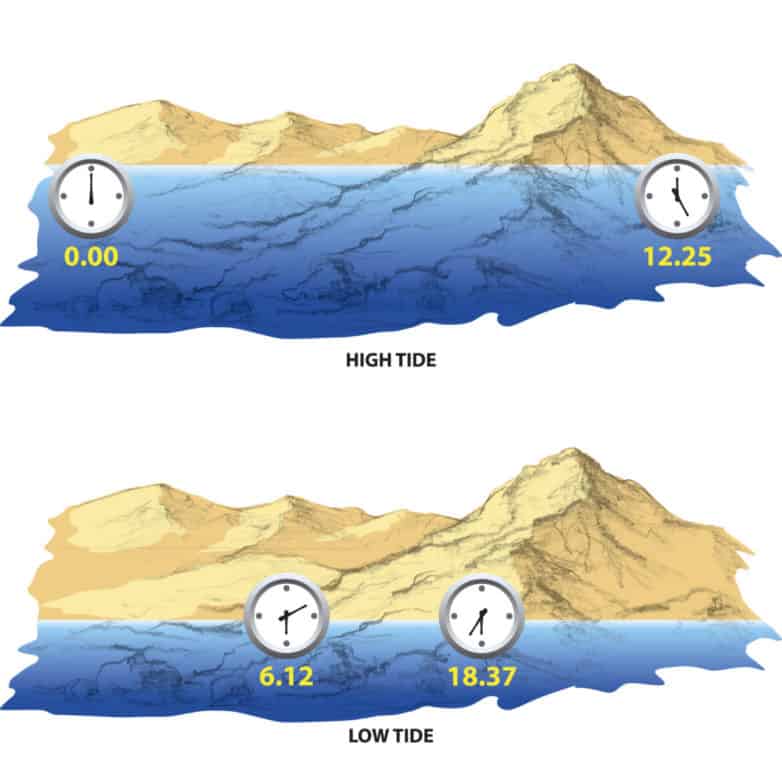
One assumption made with the solunar theory is that the fish’s biological clocks will run on lunar time. Humans run a little differently because we run on solar time, which is how we get the solar day of 24 hours.
Lunar time![]() lasts for 24 hours and 50 minutes. They are similar, but a little bit different. This can help us understand why fish seem to feed up to an hour later every solar day.
lasts for 24 hours and 50 minutes. They are similar, but a little bit different. This can help us understand why fish seem to feed up to an hour later every solar day.
Even if this were not true, and even if the fish didn’t care about the rising and setting of the moon as this theory states, the moon’s effect on the tides could be indirectly responsible for some of the habits of marine life exhibits. When the moon moves the tides, this may be enough to determine when fish will be more active or not.
There is lots of documentation on how dependent marine life is on the tides. For example, many of the saltwater fish you may want to use.
Simultaneously, surf fishing would depend on strong tidal currents and high tides. To transport their eggs from regions offshore to the shallow and protected estuaries to keep them safe.
Tides may also cause some disturbances in the seabed. When they move around, they could stir up some of the organisms that live in the bottom and give other marine life something to eat. Baitfish will notice this surge and will move onto the fish.
The game fish then feed on these baitfish, and the angler will prey on the game fish. Going out to fish when the tides move around and when game fish are looking to feed can help your fishing trip be more successful.
Who Can Use the Solunar Theory?
When you hear about the solunar theory, it usually refers to fishing and the best time to see marine life activity. That is what we will spend most of this article discussing as well.
However, fishing is not the only time this theory can be used. The solunar theory works with all animals and wildlife, not just fish and marine animals.
This means that hunters may benefit from this theory as well. While hunters would not need to focus on movements of tides and waves as much as anglers would, they can still use the moon and sun positioning to help them figure out the best time to hunt and find the animals they want.
This theory works well for anglers and hunters, as long as they can learn the moon’s movements and other factors, including the sun and tides, pertaining to the animals they want to catch.
The Major Periods
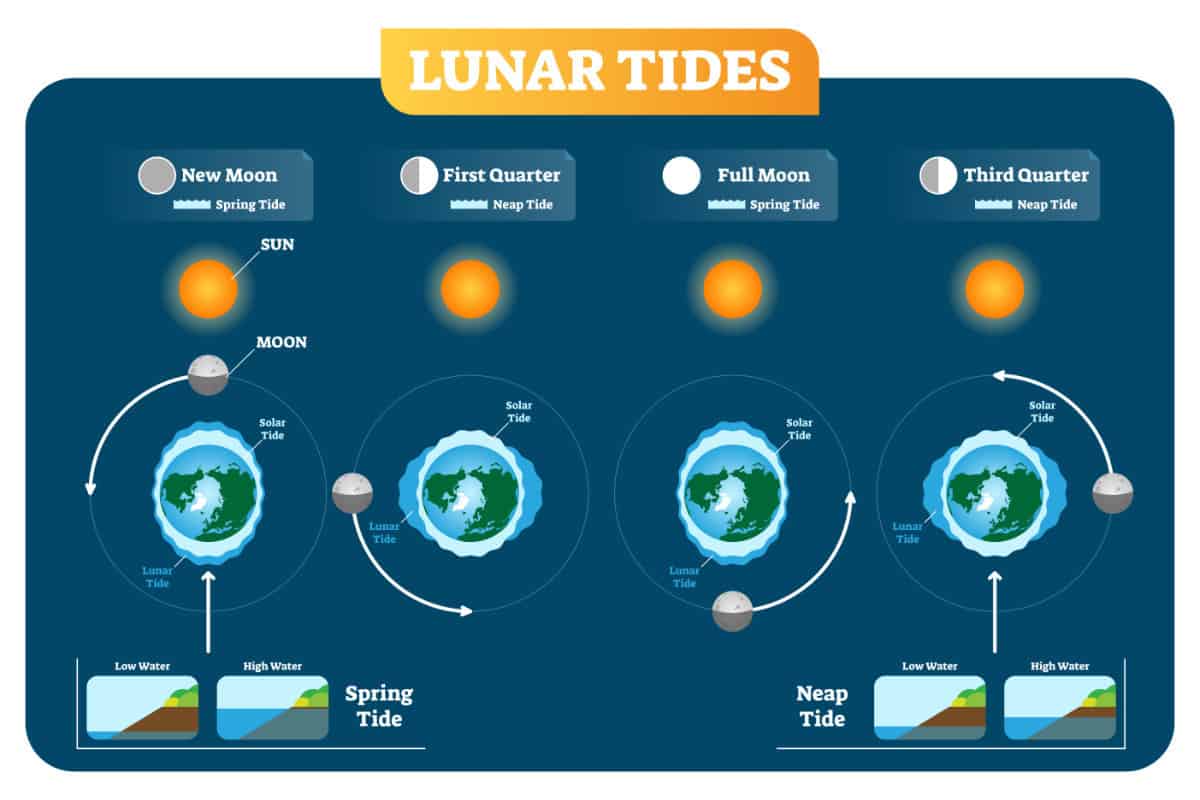
Suppose you want to get the most out of the solunar theory. In that case, it is important to understand the major and minor periods’ importance. Both of these are perfect times to get out on the water and start fishing, though the major periods are usually the best.
How is an angler supposed to know when one of these major periods occurs? When should an angler get out on the water and start fishing?
Since the major periods are the best time to see high activity with marine life, we need to focus on this first. The major periods will be when the moon is directly overhead or directly below a reference latitude.
This means it is straight above your head or under your feet, directly on the other side of the world. Minors are when the moon is slightly off, about 90 degrees, to either side.
When the moon is in this position, it has a great pull on the tides. Whether the angler believes in the solunar theory, many agree that tides will influence when fish come closer to the shore.
When the moon pulls the waves and causes bigger tides near the shore, the fish come with it. This is why you can see more activity on or near the shore when the moon is directly above you. And this is the major period.
While fishing during the major isn’t always a guarantee, it is still a good time to gather your supplies and head to the ocean. You are more likely to catch the fish you want without sitting around wasting time.
Many records happen during one of the major periods. You may get lucky and get to pull one in of your own.
The major periods last two hours for each one during the day. Once you learn how to chart these periods, you will find when one is likely to start and get two hours to enjoy fishing and seeing some good activity from marine life.
The minor periods are a little bit shorter at one hour, but still provide a good amount of time to fish.
The Minor Periods
It is also important to look at the minor periods. These are not as active for marine life as the majors. There is still a good deal of activity, though, and it is higher than waiting until another time of day.
We must remember that fish do not eat all day long, just like humans, so assuming they will sit around waiting for your bait any day is foolish. The major and minor periods are the times when fish are more likely to look for food.
The minor period will be when the moon is no longer right above or below you. Instead, the minor will happen when the moon is positioned about 90 degrees to either side. It doesn’t have to be perfect.
When the moon gets to this position, it can pull on the tides a little bit again. Though not as much as the major periods, causing more fish and marine life to be active and helping you catch more on your trip as well.
The movements between the earth and the moon mean that the majors and minors will happen just a little over six hours apart.
If you find a good major to focus on, you want to know when to get back out after it, count six hours ahead, and start fishing again.
When the days and the nights on earth are close to equal in length, which will happen at the fall and spring equinoxes in September and March, a major at dawn will cause the minor to happen at noon.
Another major happening around dusk follows this. This is a great day to be out on the water since you will get to majors while it is still bright out.
This can also tell you days that are less likely to be good for fishing. Wintertime often has fewer major periods during the day, making it a bad time to start your fishing adventure.
In winter, the noon major will be surrounded by some minors before dawn and usually after dark. Many anglers agree these are not the prime times to fish.
What Are the Solunar Tables?
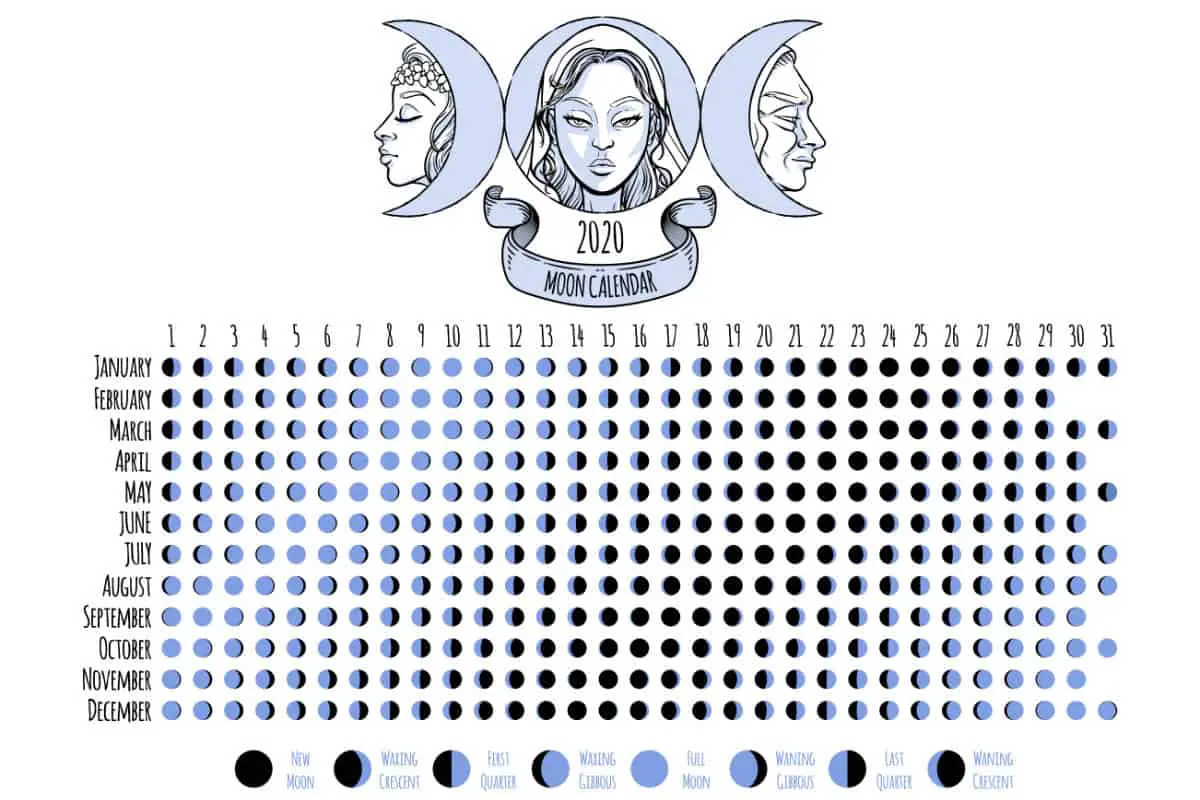
These solunar tables are simply charts that a fisherman or a hunter can use to help determine the best days of the month, and the best times of the day, to hunt or fish.
Knowing the time of the different tides, the sunset, and the sunrise makes it easier for fishermen to predict when fish are more likely to bite. If a hunter uses this, then the tides will not be a factor; they would use the moon and sun’s alignment to learn when the game is more likely to move around.
This theory assumes that all other conditions are favorable. Fish will feed, wildlife will move around, birds will fly, and all living things are more active than at other times.
Anglers use this as a guide to tell them the best time to fish during the day, so they see their sport’s quality improved. While this isn’t always a guarantee because other factors, like the weather, are not consistent and not always favorable, it is a good way to plan your activities.
With the help of these solunar tables, a hunter and an angler can tell when the moon is right overhead or right below them. The strongest activity will happen when there is a new moon or a full moon.
The combined force of gravity from the moon and the sun will always be stronger when both are right above or right below our heads.
Thanks to modern technology, we now have access to some of the best lunar data thanks to improved technology.
The US Naval Observatory![]() helps to pull in this data and provides it to those who are interested.
helps to pull in this data and provides it to those who are interested.
GPS technology![]() has also improved to make it easier to learn the lunar movements.
has also improved to make it easier to learn the lunar movements.
As an angler or hunter, you can easily find some of these charts and graphs online through different websites and blogs. You may even find one of your favorites to use every time.
Always reverify the information with data available from the US Naval Observatory, and compare it with other reputable data providers. It is easy to get consistencies that will throw off any fishing or hunting expedition you want to take.
How Accurate Is the Solunar Theory?
It is essential to know how accurate the solunar theory is before you place all hope of a successful fishing trip on it working. Many anglers have used this theory to help them catch record fish or to have more luck while on the water.
It helps you learn the exact best times to get out on the water and catch the most fish.
Not every fishing trip will bring in great record fish, but if you want to make it more likely you will feel something in, this theory is one of the best ways to make that happen.
This is not a theory that all anglers choose to work with. Some anglers find that it relies too much on the unknown, and they stick with their favorite fishing spots and head out at times they know have been successful before.
Other anglers swear by this method and like how simple and easy it is for ensuring the best catch.
Each angler has to remember that while the solunar theory is very accurate and can increase the likelihood that you will catch fish, it is not full proof.
Weather patterns, air pressure changes, and other issues can affect marine life and make the solunar theory less accurate.
According to this theory, if you have a big cold front sneak through the area, you would like to fish. Don’t be surprised if you go out and don’t catch anything, even during the perfect periods.
Several things will affect how well the solunar tables can predict good times for fishing. Local weather patterns, as we have discussed, are essential.
Barometric changes, especially when they include a downward trend, is important and can ruin the fishing you will do. While we rely on the weatherman and predictions online to tell us how the weather is doing.
Fish and other wildlife have a unique ability to predict the weather, and they act according to those predictions.
If a fish senses that a cold front is coming, they will dive deeper to stay warm and avoid it even if we don’t realize it. Suppose the barometer pressure remains steady and rising.
In that case, the air temperature is close to 15 degrees Fahrenheit higher than the water temperature. Then the solunar prediction is more likely to be accurate.
And finally, consider spawning times. These may make the fish act differently than the solunar theory will suggest. These are critical factors in some of the seasonal patterns when you fish in freshwater.
When looking at a solunar table, consider whether the temperatures have changed and whether spawning time may occur when you want to fish.
Best Times and Days to Catch Fish
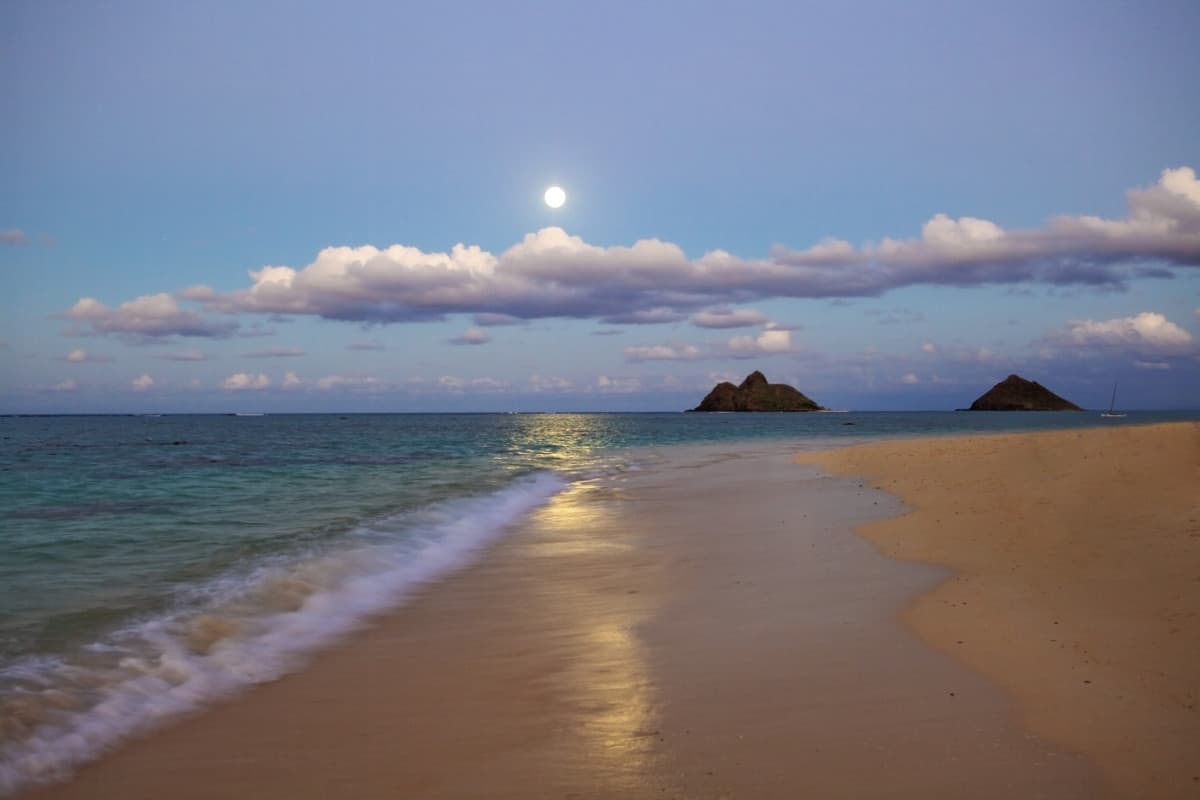
The next question many anglers may have is when to go out fishing to see the highest activity. Any time you can get out right after sunset and right before sunrise will provide more activity than in the middle of the day.
According to this theory, some specific times match up with the moon phases that you can consider when planning your trip.
The peak activity times will fall when one of the major or minor periods falls half an hour to an hour within the sunrise or sunset of the day.
When moonrise or moonset occurs during that same period, the fish’s activity will be even higher. You can see the highest times when the moon is new or full.
The whole month’s peak will happen during a new moon, so pay special attention to this.
When there is a new moon, the moon’s gravitational pull and the sun work together, causing some of the month’s highest tides. With higher tides means more activity with the fish you would like to catch.
If you happen to miss this peak day, the second-best day will be during the full moon. This moon will also increase the activity of the tides during two lunar phases. This can increase activity on the days before, during, and after the new moon.
There is even a peak month that you can consider. Most anglers agree that the peak month for surf fishing and other saltwater adventures is in June.
This is because it falls at the perfect time of year to give it more combined sun and moon influence than any other months.
If you are planning a big fishing trip and want to make sure you get out there at the right time, go during the new moon in June, and you are sure to have lots of luck.
Keep in mind that even if you do go at the full moon at dusk or dawn in June, this isn’t a guarantee that nothing will go wrong with your fishing trip.
You need to consider a few other factors like the weather, air pressure, the location you plan to fish, and more. When they get bad enough, some of these conditions may override what effect the moon has on the tides, and your fishing trip may not go as well.
For example, if you go to an area that gets an unexpected cold front moving in, even two full moons happening on your trip will not help you see more water activity.
This theory is good at giving you an idea of when the best fishing is possible, but other factors can and do step in and will mess with how much fun you can have catching fish.
However, if you plan a nice fishing trip based on the solunar theory and watch the weather to make sure a cold front or a hurricane isn’t happening. Then using the suggested times above will make it easier to catch the fish that you want.
Conclusion
The solunar theory is one of the best ways to learn the marine life movements around you and pick a good time to go fishing.
It isn’t always accurate, but by paying attention to the moon phases and learning how this works with the biological clock of marine life, you can choose times better than others to get out on the water and see more activity.
Using this theory is the trick many anglers need to make any fishing trip a success.
Sources:
Solunar: The Solunar Theory
TidesPro: Solunar Theory
Texas Saltwater Fishing: Solunar Theory
Florida Fish and Wildlife Conservation Commission: Solunar Theory and Fishing
In-Fisherman: Understanding Moon Phases
Mydwc: Solunar Theory and Fishing
Solunar Forecast and Prediction: Solunar Forecast
The United States Naval Observatory: Naval Oceanography Portal
Wikipedia: Lunar Geologic Timescale

